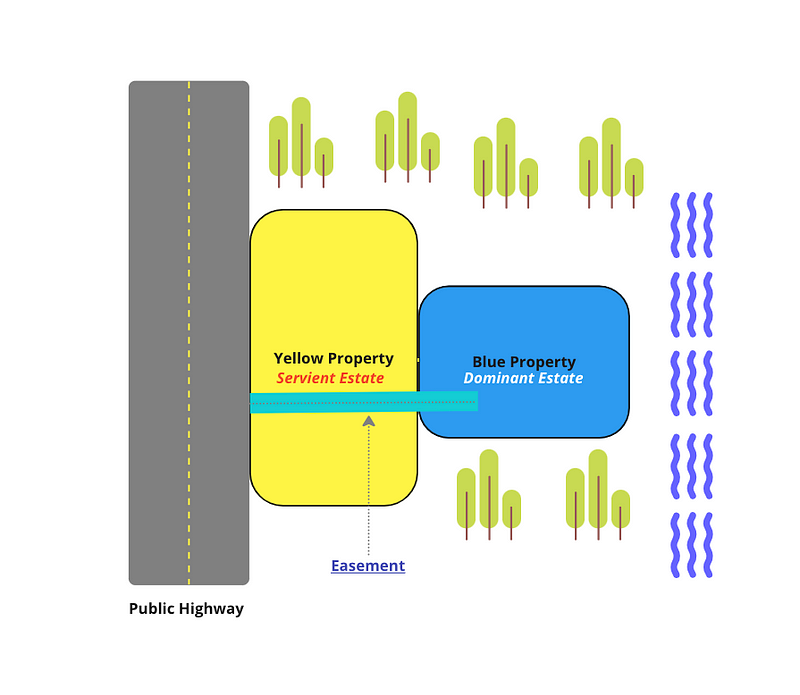Easements in Property Law: Introduction
Today we will work on the concept of easements, making it accessible and relevant to everyone from homeowners to property developers. Whether you are managing a piece of land, planning a project, or simply curious about how land use rights affect property, this article shall provide you with the essential insights into the easements regulation. Here, you will find practical information, clear examples, and an easy-to-understand breakdown of this unpopular legal topic.
What’s an Easement Anyway?
Simply put, an easement is a legal permission for someone to use land that they do not own, for a specific purpose. It is like having a key to a gate that lets you walk through your neighbor’s property to get to the beach. You do not own the land, but you can use it in a way that is been agreed upon. Keep in mind, though, this does not mean you can set up camp and live there — it is about limited use.
A formal definition of easement: “…an interest in land owned by another person, consisting in the right to use or control the land, or an area above or below it, for a specific limited purpose (such as to cross it for access to a public road).” Black’s Law Dictionary (9th Ed. 2009).

The Two Faces of Easements: Affirmative and Negative
Easements come in two main flavors:
- Affirmative Easements: Imagine you have a special permission slip that allows you to use a portion of someone else’s land. This is what an affirmative easement is like. For instance, you might have the right to walk through a neighbor’s yard to get to a nearby road or public beach. It’s a specific allowance to use someone else’s land for a designated purpose, but you do not own or control the rest of their property.
- Negative Easements: On the flip side, negative easements are all about saying “no.” They allow you to prevent certain uses of your neighbor’s land that might affect your property negatively. For example, a negative easement could stop your neighbor from building a high fence that would block your beautiful ocean view. It is a way to preserve certain aspects of your property, like views or sunlight, by placing restrictions on how neighboring land can be used.
The Trio of Easement Types
Easements, intricate as they are, come in three distinct types. Each type plays a unique role in property usage and rights.
- Easement Appurtenant: This type of easement creates a link between two separate pieces of land, known as the ‘dominant’ and ‘servient’ estates. The dominant estate is the one that benefits from the easement, while the servient estate is the land over which the easement is granted. A common example is when you have the right to use a pathway that cuts through your neighbor’s property. In this case, your property (the dominant estate) benefits from this right, while your neighbor’s land (the servient estate) is the one that accommodates this pathway. The unique aspect of an easement appurtenant is that it is attached to the land itself, not the landowner. This means if either the dominant or servient property is sold, the easement continues with the new owner.
- Easement in Gross: Unlike easement appurtenant, an easement in gross does not involve a dominant estate. Instead, it benefits a person or a company, regardless of property ownership. This type is commonly seen with utility companies. For example, a power company may have an easement in gross to install and maintain power lines across several properties. Here, the benefit is not attached to any particular piece of land the company owns, but to the company itself. Easements in gross can be personal or commercial. Personal easements in gross are usually non-transferable, while commercial ones, like those held by utility companies, can be transferred or assigned.
- Profit à Prendre: A profit à prendre goes a step further than other easements. It grants the right to actually remove part of the land or products of the land. This can include activities like mining, logging, or harvesting crops. For example, if you have a profit à prendre on a neighbor’s land, you might have the right to go onto their land and extract oil, if discovered there. It is like having a ticket not just to visit an orchard but to pick and keep the apples. Profits à prendre are similar to easements in gross in that they are often transferable and can be held by individuals or companies.

In summary, understanding these three types of easements — easement appurtenant, easement in gross, and profit à prendre — is usuful for anyone involved in land use and property rights. Each type has its unique characteristics and implications for how land can be used, shared, or enjoyed. Whether it’s walking through a neighbor’s yard, laying down utility lines, or extracting resources, easements play a significant role in shaping the landscape of property law.
Can You Transfer Easements?
Here’s where it gets interesting. Transferring easements can be a nuanced process, depending on the type of easement involved. Let’s explore how the transferability of easements works across different types:
- Easement Appurtenant: When an easement is appurtenant, it is intrinsically linked to the land, not the landowner. This means if you sell a property that benefits from an easement appurtenant (the dominant estate), the easement is transferred to the new owner. The same goes for the property burdened by the easement (the servient estate). It is like selling a house with a garden; the garden goes with the house. For example, if your property has an access path across your neighbor’s land, and you sell your property, the new owner will also gain the right to use that path.
- Easement in Gross for Personal Use: Personal easements in gross are more about the individual than the land. These easements are typically non-transferable, meaning they are specific to the person who was granted the easement. Consider an easement that allows you to use a shortcut across someone’s property to reach the beach. If you sell your property, you cannot transfer this right to the new owner, as it was granted specifically to you.
- Commercial Easements in Gross: These easements are more flexible regarding transferability. Commercial easements in gross, like those held by utility companies for power lines, can generally be transferred or assigned. This transferability is essential for the functioning of utility services, as it allows them to maintain infrastructure over a broad area, regardless of changes in property ownership.
- Profits à Prendre: Similar to commercial easements in gross, profits à prendre are always transferable. They can be passed on irrespective of their use, whether personal or commercial. This means that if you have the right to extract minerals from a piece of land, you can transfer this right to another party.
Conclusion
Easements may play sometimes an important role in property ownership and land use, as they represent a set of rules that define how a property can be used or accessed, not just by the owner, but also by others. Understanding easements is essential for anyone involved in real estate, whether you are buying a new home, planning a development project, or simply managing your property.
Knowing the type of easement attached to a property can help you foresee how it might affect your use of the land or its value. If you are a property owner, be aware of any existing easements and how they might restrict or benefit your use of the land. If you are purchasing property, it is crucial to investigate any easements that may come with it, as they can significantly impact your usage rights and future plans. Always consider seeking professional advice to understand the specifics of easements relevant to your property. By being informed and prepared, you can make more strategic decisions, avoid potential disputes, and fully harness the benefits and opportunities of your property. Remember, easements are not just legal terms; they are practical aspects of land ownership that require careful consideration and understanding.
* * * *
Disclaimer: The contents of this article are intended for informational and educational purposes only and should not be construed as legal advice. Always consult with a qualified attorney regarding any legal issues or matters. Relying solely on the content of this article without seeking professional legal counsel could result in adverse consequences or the misinterpretation of information.
